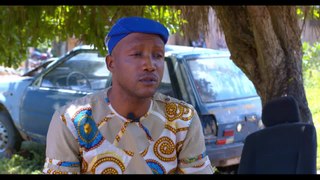Related Research Articles
The Adamawa languages are a putative family of 80–90 languages scattered across the Adamawa Plateau in Central Africa, in northern Cameroon, north-western Central African Republic, southern Chad, and eastern Nigeria, spoken altogether by only one and a half million people. Joseph Greenberg classified them as one branch of the Adamawa–Ubangi family of Niger–Congo languages. They are among the least studied languages in Africa, and include many endangered languages; by far the largest is Mumuye, with 400,000 speakers. A couple of unclassified languages—notably Laal and Jalaa—are found along the fringes of the Adamawa area.
Defaka is an endangered and divergent Nigerian language of uncertain classification. It is spoken in the Opobo–Nkoro LGA of Rivers State, in the Defaka or Afakani ward of Nkọrọ town and Ịwọma Nkọrọ. The low number of Defaka speakers, coupled with the fact that other languages dominate the region where Defaka is spoken, edges the language near extinction on a year-to-year basis. It is generally classified in an Ijoid branch of the Niger–Congo family. However, the Ijoid proposal is problematic. Blench (2012) notes that "Defaka has numerous external cognates and might be an isolate or independent branch of Niger–Congo which has come under Ịjọ influence."

There are over 525 native languages spoken in Nigeria. The official language and most widely spoken lingua franca is English, which was the language of Colonial Nigeria. Nigerian Pidgin – an English-based creole – is spoken by over 60 million people.
Pongu (Pangu), or Rin, is a Kainji language spoken in Nigeria. There are about 20,000 speakers. Their main centre is in Pangu Gari town of Niger State, about 20 kilometres southeast of Tegina.
Busa, or Bisã, is the Mande language of the former Borgu Emirate in northwestern Nigeria and northern Benin. It is called Busanci in Hausa, and has also been called Zugweya.
Lunguda (Nʋngʋra) is a Niger–Congo language spoken in Nigeria. They settle western part of Gongola mainly in and around the hills of the volcanic Lunguda Plateau, Adamawa state. Joseph Greenberg counted it as a distinct branch, G10, within the Adamawa family. When Blench (2008) broke up Adamawa, Lunguda was made a branch of the Bambukic languages.
Ukaan is a poorly described Niger–Congo language or dialect cluster of uncertain affiliation. Roger Blench suspects, based on wordlists, that it might be closest to the (East) Benue–Congo languages. Blench (2012) states that "noun-classes and concord make it look Benue-Congo, but evidence is weak."

North Akoko, usually abbreviated as Akoko and also known as Arigidi, is a dialect cluster spoken in Nigeria. It appears to form a branch of the "Yoruba–Edo–Akoko–Igbo" group of Niger–Congo languages. It is spoken in the LGAs of Akoko North East, Akoko North West, Ekiti East, and Ijumu (Ethnologue).
Oko (ɔ̀kɔ́), also known as Ogori-Magongo and Oko-Eni-Osayin, is a dialect cluster spoken in Nigeria. It appears to form a branch of the "Nupe–Oko–Idoma" group of Niger–Congo languages. Most Oko speakers also speak Yoruba as a second language. The language is spoken in and around the towns of Ogori and Magongo in southwestern Kogi State, close to the Ondo and Edo state borders.
Kwah (Kwa), also known as Baa (Bàː), is a Niger–Congo language of uncertain affiliation; the more it has been studied, the more divergent it appears. Joseph Greenberg counted it as one of the Bambukic languages of the Adamawa family. Boyd (1989) assigned it its own branch within Waja–Jen. Kleinewillinghöfer (1996) removed it from Waja–Jen as an independent branch of Adamawa. When Blench (2008) broke up Adamawa, Kwah became a provisional independent branch of his larger Savannas family.
Nyong (Daganyonga), also known as Mubako and Bali-Kumbat, is a Leko language spoken in two well-separated enclaves in Cameroon and Nigeria. Cameroonian speakers consider themselves to be ethnically Chamba.
Ahwai, also called the Ndunic languages, is a Plateau language cluster spoken to the southwest of Fadan Karshi in Sanga LGA, Kaduna State, Nigeria. Most villages are located at the foot of the Ahwai Mountains in Kaduna State.
The Kamuku languages are a branch of the Kainji languages spoken by the Kamuku people of Niger State, western Nigeria, mostly in Mariga and Rafi LGAs.
Bauchi is a cluster of Kainji languages spoken in Rafi, Nigeria LGA, Niger State, Nigeria.
Yebu is one of the Savanna languages of Kaltungo LGA in Gombe State, northeastern Nigeria.
Bali is a Niger–Congo language spoken by 100,000 people in Demsa, Adamawa, Nigeria.
Kpasam is an Adamawa language of Demsa LGA, Adamawa State, Nigeria.
Kugama, also known as Wam (Wã̀m) or Gengle, is an Adamawa language of Nigeria. It is spoken in Mayo-Belwa and Fufore Local Government Areas of Adamawa State. It is classified within the Yendang group of the Adamawa language family.
Laka or Lau is a Central Sudanic language spoken in Nigeria. It is most closely related to Kabba Laka of Chad. The Hausa refer to the Laka people of Lau as Lakawa. The language was only recently documented in the mid-2010s, and had been previously misclassified as a Mbum language along with Lau.
Sarkin Dawa is a village located in the Kam District Area in Bali Local Government Area, Taraba State, central eastern Nigeria. There is no reliable data available to estimate the total population of the village. The place falls in the territory of the Kam (Nyingwom) ethnic group but also hosts residents from various other ethnic groups. The name Sarkin Dawa refers to the village head, who is also the political king of the Kam people.
References
- ↑ Nyingwom at Ethnologue (18th ed., 2015) (subscription required)
- ↑ Blench, Roger (2019). An Atlas of Nigerian Languages (4th ed.). Cambridge: Kay Williamson Educational Foundation.
- 1 2 3 Lesage, Jakob. Kam. AdaGram.
- ↑ Kleinewillinghöfer, Ulrich. 2015. Some notes on Nyiŋɔm (aka Nyingwom or Kam).
- 1 2 3 Lesage, Jakob (2020). A grammar and lexicon of Kam (àŋwɔ̀m), a Niger-Congo language of central eastern Nigeria. Paris: Institut National des Langues et Civilisations Orientales (INALCO).